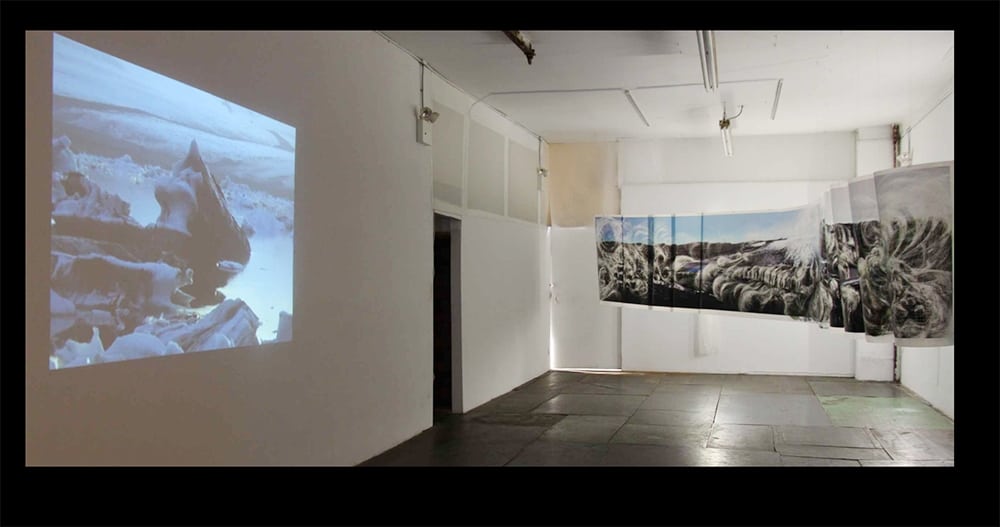Neuhaus’ latest show, “Sublimation: An Iceberg’s Story,” now at Red Hook’s Kentler International Drawing Center through February 25, features a 30-foot long panoramic photo of Russell Glacier in Southwest Greenland. The photo has meticulously been etched away, resulting in a powerful inverse painting. The chiseling captures the dry, gritty cracks that define a personal experience of glaciers; it ultimately offers a tangible feel that photos, for all their resolution, don’t convey. To up this physical sensation, Neuhaus has the work backlit by a two minute, repeating video of various glaciers.
The recordings come from her visits to Greenland and Iceland last summer, though the genesis of this piece can be traced to 2015, when Neuhaus joined a group of Fulbright scholars to the Arctic. On average, the Russell Glacier moves at least 80 feet a year, and this movement, as well as the thermal energy beneath it, captured Neuhaus’s imagination. Like Patty’s Chang’s “Wandering Lake” at The Queens Museum through March 4, a media piece split onto screens where Chang washes an abandoned tanker in the Aral Sea, “Sublimation” is also split into several sections that echo humanity’s fractured attempt to connect to nature, as well as the futile attempt to reverse its destruction.
Neuhaus has an admirable philosophy of thought first medium second. Consequently, her previous work has incorporated sculpture, collage, video, performance, and installation. Those confluences are easy to see with this exhibit, which incorporates drawing, photography, video, and installation.
The overall work is meticulous and beautiful. It echos the Canadian artist Sarah Anne Johnson’s “Arctic Winterland,” a collection of original photography from the Arctic circle on which Johnson splattered ominous paints and severe, over-sized buildings onto the once unblemished landscape. As Roy Scanton’s essay accompanying the “Sublimation” reads, “Reality is a composite of here and there, then and now, subjectivity and fact. Reality is a haunted palimpsest, a photo etched with future ghosts. Reality is a flickering projection.”
You can make what you will of the exhibition’s title. “Sublimation” can be a critique of the collective defense mechanism of ignoring impending ecological collapse by through one’s prefered distraction. It can also be considered a reflection of the change that Neuhaus said overtook her after visiting northern glaciers over the years. In geothermal terms, sublimation happens when a solid becomes a gas without ever going through the liquid phase.
Neuhaus writes that she had a particularly sharp experience upon seeing one iceberg that seemed resolute not to move while other icebergs cracked and floated away from the Kangerlussuaq glacier. She gave a name to this glacier, Icylla. There’s a “The Story of Icylla” aspect that lacks the compelling vision of the focal piece. It’s redolent of a romanticizing of the north (being from Alaska, I feel like I can say this with some validity). From Jack London to “Into the Wild” and “The Snow Child,” there’s something about this romanticizing and projecting impulse on the north that always makes me brace. But overall, this exhibition serves an important function. As Scanton writes, “Itty Neuhaus’s Sublimation connects Red Hook, Brooklyn to Greenland, here to there, then to now, in ways that subvert and complicate our typical thinking about the Arctic’s spectacular doom.”
No arguing with that.
Kentler Drawing Center at 353 Van Brunt St hosts the show until February 25. Neuhaus will give a talk February 13, Tuesday, on the work’s evolution.









